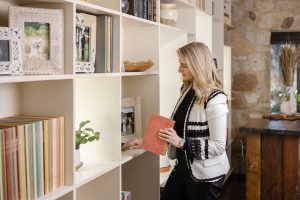Streamlined Style
A two-pronged approach for your best spring cleaning yet.
As we approach warmer, longer days and this season’s blooming beauty, we’re inspired to consider our own fresh starts—beginning in the home. This year, set yourself up for spring cleaning success with two key phases: simplifying and styling. “There is real peace of mind in having a tidy home,” says Rebecca Pecorelli of Serenity Sorted. “Knowing where things are helps us to feel grounded, and can help us to live more efficient, joyful lives.”

Paring down and organizing the items of a room can be a significant makeover in and of itself—but for those seeking continued change in a space, a design refresh might be just the thing. “Our surroundings can dictate our mood and our outlook,” says Emily McKenney of Studio Havlan. “If I get to wake up every morning in my bedroom and see new wallpaper that I’ve chosen and curtains that I love, it’s going to have a positive effect on how I move through the day.”
Here, Pecorelli and McKenney share tips on the simplifying and styling processes, and how to leverage one—or both—to breathe new life into our most everyday spaces now.
Phase I: Simplify
Rebecca Pecorelli, Serenity Sorted
Determine your area

Rebecca Pecorelli of Serenity Sorted
When it comes to decluttering a space in your home, Pecorelli suggests a strategic approach. “Begin with a high-traffic, daily use area, such as the kitchen, bathroom, or coat closet.” She also notes the importance of setting a goal before embarking on the process—and though that might look different for everyone, she offers one with universal merit. “Having things in a convenient space that makes sense can make a big difference in our daily lives,” she says, referencing Benjamin Franklin’s famous quote: “For every minute spent in organizing, an hour is earned.” Look at your dishes—are they far from the dishwasher or close? What about a space for mail and car keys—near the front door? Consider your daily rhythms to help determine a vision to work towards.
Sort and purge
Once you choose your focus area, Pecorelli suggests removing all its current contents and sorting items by category so that you know exactly how much you have of everything. Next, look at what you want to keep, donate, toss, or sell. Further categories could include daily use, weekly use, occasional use, or overstock.
“Ideally, the daily use items are placed in the easiest to reach places, while occasional use or overstock can go into storage,”
says Pecorelli, giving the examples of keeping favorite snacks in a go-to drawer, and extra paper towel rolls in the back of a closet until needed. The same approach can be used for toiletries, accessories, office supplies, as well as clothing and shoes.
Containment and labeling

Photo: Serenity Sorted
Only after the point of purging and understanding how much you have left to keep is when Pecorelli advises clients shop for products that will help them in the organizing and streamlining process, such as bins, dividers, filing cabinets, and shelving units (pro tip: be sure to measure your space before making any purchases).
Pecorelli also notes how helpful label-making can be along the way.
“Labels help everyone in the household, even if it’s just yourself, to remember where things go.”
Maintenance
“Once you’ve put everything back into their new spaces and have your system set up, it’s all about maintenance and being diligent about keeping things in the spots you’ve created for them,” says Pecorelli. While your new system will hopefully do away with any miscellaneous piles, Pecorelli shares that there are a couple of exceptions she employs at home.
“I have an in-process bin for items of a certain space that I can’t get to in that moment but intend to soon, and I also have an outgoing bin for items that need to leave the house—donations, mail, returns,” she says.
“This way, when I’m out the door, it’s ready for me to grab it and go.”
Phase II: Style
Emily McKenney, Studio Havlan
Reflect

Emily McKenney by Victoria Chukarov Photography
In reimagining any space of the home, McKenney notes the importance of creating a clear intention—and that a helpful way to do so is to pause, grab a pen and paper, and take in your surroundings.
“Start with one room of the home, or one part of the room—and spend some time there,” says McKenney, who suggests jotting down a few key details, including what you love about the space, what you dislike about the space, what purpose you want the space to serve, and—a key one—how you want to feel in the space.
“If this is a room that you want to feel comfortable and cozy in but the chairs you currently own aren’t providing that feeling, you now have a priority item to shop for.”
Seek inspiration
With your journaled notes, McKenney suggests doing some digital window shopping. “Browse through magazines that interest you like Architectural Digest or search keywords from your room reflection, such as ‘cozy family room’ or ‘modern kitchen,’”

Victoria Chukarov Photography
she says, noting searching for content around everything from color schemes and textures to furniture placement and products. “If you put together a design board online, you could incorporate images that you’re most excited about—ones of spaces in which you can really envision yourself,” says McKenney. Certain sites accommodate specificity (e.g. seeing oneself in a living area by the roaring fireplace, resting on a bespoke sofa alongside a vintage, hand-knotted rug).
Shop (with a plan)
Before you start shopping, McKenney suggests revisiting your space to determine what items are most important to replace, especially if there are budget or space constraints.

photo by Victoria Chukarov Photography
“For example, if you are thinking about purchasing a new rug, ask yourself: is the current rug damaged? Is it the right size for the space?” notes McKenney.
“Then consider whether it’s a rug you need, or if you might feel closer to your goal through the purchase of a different item that holds more meaning or importance for you now.” With a shopping plan in place (and after taking all measurements for the space and desired items), McKenney recommends visiting shops in-person and online.
Wow factor wallpaper and statement bookshelves
If you are generally happy with your home spaces but are looking for a singular project that can offer significant refresh, McKenney has two favorite thoughts: wallpaper and bookshelves. “Wallpaper can warm up a room and give it texture; it can be subtle or bold—the options are endless,” says McKenney, who has used various patterns for her client work, from whimsical floral to a striped grass cloth. Bookshelves, McKenney notes, are another part of the home that can serve as a blank slate. “You can change the entire feeling of a room by the way you style your bookshelves,” she says, referencing her own as an example, lined with family portraits, heirlooms, and travel mementos alongside antique and vintage books (some of which McKenney displays open).
“Bookshelves are some of my favorite projects to take on—they can tell us so much about a person, and about a family.”
Expert Takeaways
Start small
To help ensure success in your home project, both Pecorelli and McKenney suggest starting small.
“Some days, you might only have 15 minutes to devote to tidying,” says Pecorelli. “In those instances, focusing on something achievable like a nightstand or one drawer can feel great to tackle.”
McKenney agrees. “Choosing one small area of a room, such as a reading area or breakfast nook, can start to build a clear, realistic vision.”
Take breaks
If at any point the simplifying or styling begins to feel overwhelming, remember to give yourself grace. “Organizing is a process, and it can take several sessions before the area is complete,” says Pecorelli. “It will usually get messy before it gets better, but don’t give up—keep at it, because you’re on the right track.”
McKenney shares similar insights:
“When you’re sifting through all of the details of a redesign, it can be important to take breaks from the project—to literally stand up and leave the room, give yourself a day or two, and return to it with fresh eyes.”
Celebrate
When the project is complete, both experts encourage taking a moment to soak it all in. “Take time to sit in your new space and remind yourself of the last time you were here, planning out your design and thinking of how you wanted to feel,” says McKenney. Digital documentation, too, can serve as a sweet—and inspiring—takeaway.
“Be sure to capture before and after pictures, so that you can admire your work,” says Pecorelli. “It will be rewarding for you to look back on all you’ve accomplished.”
–
This story appears in One Adventures, Berkley One’s digital magazine celebrating creators, experiences and stories. Read the issue here.
Want even more One Adventures? Read our other issues: Issue 01; Issue 02; Issue 03; Issue 04; Issue 05; Issue 06; Issue 07; Issue 08; Issue 09
Berkley One is a Berkley Company.



